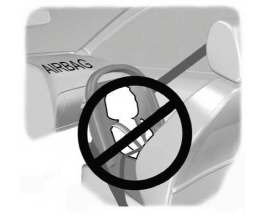Lincoln Aviator: Catalytic Converter / On-Board Diagnostics (OBD-II)
Your vehicle has a computer known as the on-board diagnostics system (OBD-II) that monitors the engine’s emission control system. The system protects the environment by making sure that your vehicle continues to meet government emission standards. The OBD-II system also assists a service technician in properly servicing your vehicle.
 When the service engine soon
indicator illuminates, the OBD-II
system has detected a malfunction.
Temporary malfunctions may cause the
service engine soon indicator to illuminate.
Examples are:
When the service engine soon
indicator illuminates, the OBD-II
system has detected a malfunction.
Temporary malfunctions may cause the
service engine soon indicator to illuminate.
Examples are:
- Your vehicle has run out of fuel—the engine may misfire or run poorly.
- Poor fuel quality or water in the fuel—the engine may misfire or run poorly.
- The fuel fill inlet may not have closed properly.
- Driving through deep water—the electrical system may be wet.
You can correct these temporary malfunctions by filling the fuel tank with good quality fuel, properly closing the fuel fill inlet or letting the electrical system dry out. After three driving cycles without these or any other temporary malfunctions present, the service engine soon indicator should stay off the next time you start the engine. A driving cycle consists of a cold engine startup followed by mixed city and highway driving. No additional vehicle service is required.
If the service engine soon indicator remains on, have your vehicle serviced at the first available opportunity. Although some malfunctions detected by the OBD-II may not have symptoms that are apparent, continued driving with the service engine soon indicator on can result in increased emissions, lower fuel economy, reduced engine and transmission smoothness and lead to more costly repairs.
 Catalytic Converter
Catalytic Converter
WARNING: Do not park, idle or drive
your vehicle on dry grass or other dry
ground cover. The emission system heats
up the engine compartment and exhaust
system, creating the risk of fire...
 Readiness for Inspection and Maintenance (I/M) Testing
Readiness for Inspection and Maintenance (I/M) Testing
Some state and provincial and local
governments may have
Inspection/Maintenance (I/M) programs to
inspect the emission control equipment on
your vehicle...
Other information:
Lincoln Aviator 2020-2025 Service Manual: Description and Operation - Instrument Panel and Interior Switches Illumination - System Operation and Component Description
System Operation System Diagram - Networked Illumination - Doors NOTE: Not all vehicles come equipped with all the items listed below. The door latch modules are identified as follows: Left front door - DCME Right front door - DCMF Left rear door - DCMG Right rear door - DCMH Item Description 1 MS-CAN 2 DCME 3 Light sensor 4 DCMF 5 DCMH 6 DDM 7 PDM 8 RF door lock switch 9 RF door window control switch 10 LF door window control switch 11 RR door window control switch 12 LR door window control switch 13 LF door lock switch 14 RR door lock switch 15 LR door lock switch 16 GWM 17 DCMG 18 LH front interior door latch switch 19 RH front interior door latch switch 20 LH rear interior door latch switch 21 RH rear interior door latch switch 22 LIN 23 LIN 24 HS-CAN1 25 BCM 26 Dimmer switch 27 Headlamp switch System Diagram - Networked Illumination - Steering Wheel Switches Item Description 1 Light sensor 2 RH lower steering wheel switch 3 RH upper steering wheel switch 4 LH lower steering wheel switch 5 LH upper steering wheel switch 6 SIMA 7 Upshift paddle switch 8 Downshift paddle switch 9 HS-CAN2 10 GWM 11 HS-CAN1 12 LIN 13 BCM 14 Dimmer switch 15 Headlamp switch System Diagram - Networked Illumination - Other Modules Item Description 1 FCIM 2 APIM 3 Light sensor 4 ACM 5 IPC 6 FDIM 7 without Touchscreen 8 FCDIM 9 RHVAC 10 RACM 11 LIN 12 HS-CAN1 13 MS-CAN 14 HS-CAN3 15 GWM 16 Dimmer switch 17 Headlamp switch 18 BCM Network Message Chart Module Network Input Messages - ACM, APIM, DCME, DCMF, DCMG, DCMH, DDM, FCIM, RACM, RHVAC, SIMA, GWM, IPC and PDM...
Lincoln Aviator 2020-2025 Service Manual: Removal and Installation - Oil Pan
Materials Name Specification Motorcraft® High Performance Engine RTV SiliconeTA-357 WSE-M4G323-A6 Motorcraft® Silicone Gasket RemoverZC-30-A - Motorcraft® Metal Surface Prep WipesZC-31-B - Motorcraft® Metal Brake Parts CleanerPM-4-A, PM-4-B - Removal NOTICE: During engine repair procedures, cleanliness is extremely important...
Categories
- Manuals Home
- Lincoln Aviator Owners Manual
- Lincoln Aviator Service Manual
- Fuel Quality
- Resetting the System
- Drive Modes
- New on site
- Most important about car
Children and Airbags
WARNING: Airbags can kill or injure a child in a child restraint. Never place a rear-facing child restraint in front of an active airbag. If you must use a forward-facing child restraint in the front seat, move the seat upon which the child restraint is installed all the way back.

